Do Artificial Neural Networks Always Provide High Prediction Performance? An Experimental Study on the Insufficiency of Artificial Neural Networks in Capacitance Prediction of the 6H-SiC/MEH-PPV/Al Diode
Abstract
:1. Introduction
2. Literature Review
3. Experimental Model
4. ANN Model Development
5. Results and Discussion
6. Conclusions
Author Contributions
Funding
Institutional Review Board Statement
Informed Consent Statement
Data Availability Statement
Conflicts of Interest
References
- McCulloch, W.S.; Pitts, W. A logical calculus of the ideas immanent in nervous activity. Bull. Math. Biophys. 1943, 5, 115–133. [Google Scholar] [CrossRef]
- Ding, S.; Li, H.; Su, C.; Yu, J.; Jin, F. Evolutionary artificial neural networks: A review. Artif. Intell. Rev. 2013, 39, 251–260. [Google Scholar] [CrossRef]
- Tanty, R.; Desmukh, T.S. Application of artificial neural network in hydrology—A review. Int. J. Eng. Technol. Res. 2015, 4, 184–188. [Google Scholar]
- Thakur, N.; Han, C.Y. Indoor Localization for Personalized Ambient Assisted Living of Multiple Users in Multi-Floor Smart Environments. Big Data Cogn. Comput. 2021, 5, 42. [Google Scholar] [CrossRef]
- Pavićević, M.; Popović, T. Forecasting Day-Ahead Electricity Metrics with Artificial Neural Networks. Sensors 2022, 22, 1051. [Google Scholar] [CrossRef]
- Yadav, A.K.; Chandel, S. Solar radiation prediction using Artificial Neural Network techniques: A review. Renew. Sustain. Energy Rev. 2014, 33, 772–781. [Google Scholar] [CrossRef]
- Kumar, R.; Aggarwal, R.; Sharma, J. Energy analysis of a building using artificial neural network: A review. Energy Build. 2013, 65, 352–358. [Google Scholar] [CrossRef]
- Sharma, P.; Bhatti, T. A review on electrochemical double-layer capacitors. Energy Convers. Manag. 2010, 51, 2901–2912. [Google Scholar] [CrossRef]
- Rhoderick, E.; Williams, R. Metal-Semiconductor Contacts; Clarendon: Oxford, UK, 1988. [Google Scholar]
- Liu, Q.; Lau, S. A review of the metal–GaN contact technology. Solid-State Electron. 1998, 42, 677–691. [Google Scholar] [CrossRef]
- Blom, P.; Wolf, R.; Cillessen, J.; Krijn, M. Ferroelectric schottky diode. Phys. Rev. Lett. 1994, 73, 2107. [Google Scholar] [CrossRef]
- Rideout, V. A review of the theory, technology and applications of metal-semiconductor rectifiers. Thin Solid Film. 1978, 48, 261–291. [Google Scholar] [CrossRef]
- Zhao, J.H.; Sheng, K.; Lebron-Velilla, R.C. Silicon carbide schottky barrier diode. Int. J. High Speed Electron. Syst. 2005, 15, 821–866. [Google Scholar] [CrossRef] [Green Version]
- She, X.; Huang, A.Q.; Lucía, Ó.; Ozpineci, B. Review of silicon carbide power devices and their applications. IEEE Trans. Ind. Electron. 2017, 64, 8193–8205. [Google Scholar] [CrossRef]
- Wang, X.; Qi, J.; Yang, M.; Zhang, G. Analysis of 600 V/650 V SiC schottky diodes at extremely high temperatures. CPSS Trans. Power Electron. Appl. 2020, 5, 11–17. [Google Scholar] [CrossRef]
- Lim, S.; Kwon, D.; Eum, J.-H.; Lee, S.-T.; Bae, J.-H.; Kim, H.; Kim, C.-H.; Park, B.-G.; Lee, J.-H. Highly Reliable Inference System of Neural Networks Using Gated Schottky Diodes. IEEE J. Electron. Devices Soc. 2019, 7, 522–528. [Google Scholar] [CrossRef]
- Rabehi, A.; Nail, B.; Helal, H.; Douara, A.; Ziane, A.; Amrani, M.; Akkal, B.; Benamara, Z. Optimal estimation of Schottky diode parameters using a novel optimization algorithm: Equilibrium optimizer. Superlattices Microstruct. 2020, 146, 106665. [Google Scholar] [CrossRef]
- Mellit, A.; Sağlam, S.; Kalogirou, S.A. Artificial neural network-based model for estimating the produced power of a photovoltaic module. Renew. Energy 2013, 60, 71–78. [Google Scholar] [CrossRef]
- Alade, M.O. High Temperature Electronic Properties of a Microwave Frequency Sensor–GaN Schottky Diode. Adv. Phys. Theor. Appl. 2013, 15, 47–53. [Google Scholar]
- Darwish, A.; Hanafy, T.; Attia, A.; Habashy, D.; El-Bakry, M.; El-Nahass, M. Optoelectronic performance and artificial neural networks (ANNs) modeling of n-InSe/p-Si solar cell. Superlattices Microstruct. 2015, 83, 299–309. [Google Scholar] [CrossRef]
- Mittal, M.; Bora, B.; Saxena, S.; Gaur, A.M. Performance prediction of PV module using electrical equivalent model and artificial neural network. Sol. Energy 2018, 176, 104–117. [Google Scholar] [CrossRef]
- Liang, A.; Xu, Y.; Jia, S.; Sun, G. Neural networks for nonlinear modeling of microwave Schottky diodes. In Proceedings of the International Conference on Microwave and Millimeter Wave Technology, Nanjing, China, 21–24 April 2008; IEEE: Piscataway, NJ, USA, 2008; pp. 558–561. [Google Scholar]
- Torun, Y.; Doğan, H. Modeling of Schottky diode characteristic by machine learning techniques based on experimental data with wide temperature range. Superlattices Microstruct. 2021, 160, 107062. [Google Scholar] [CrossRef]
- Rahman, A.A.; Zhang, X. Prediction of oscillatory heat transfer coefficient for a thermoacoustic heat exchanger through artificial neural network technique. Int. J. Heat Mass Transf. 2018, 124, 1088–1096. [Google Scholar] [CrossRef]
- Pang, Z.; Niu, F.; O’Neill, Z. Solar radiation prediction using recurrent neural network and artificial neural network: A case study with comparisons. Renew. Energy 2020, 156, 279–289. [Google Scholar] [CrossRef]
- Gao, W.; Guirao, J.L.; Basavanagoud, B.; Wu, J. Partial multi-dividing ontology learning algorithm. Inf. Sci. 2018, 467, 35–58. [Google Scholar] [CrossRef]
- Gao, W.; Wang, W.; Dimitrov, D.; Wang, Y. Nano properties analysis via fourth multiplicative ABC indicator calculating. Arab. J. Chem. 2018, 11, 793–801. [Google Scholar] [CrossRef]
- Gao, W.; Wu, H.; Siddiqui, M.K.; Baig, A.Q. Study of biological networks using graph theory. Saudi J. Biol. Sci. 2018, 25, 1212–1219. [Google Scholar] [CrossRef]
- Gao, W.; Guirao, J.L.G.; Abdel-Aty, M.; Xi, W. An independent set degree condition for fractional critical deleted graphs. Discret. Contin. Dyn. Syst.-S 2019, 12, 877. [Google Scholar] [CrossRef] [Green Version]
- Dimitrov, D.; Abdo, H. Tight independent set neighborhood union condition for fractional critical deleted graphs and ID deleted graphs. Discret. Contin. Dyn. Syst.-S 2019, 12, 711. [Google Scholar] [CrossRef] [Green Version]
- Bas, E.; Uslu, V.R.; Egrioglu, E. Robust learning algorithm for multiplicative neuron model artificial neural networks. Expert Syst. Appl. 2016, 56, 80–88. [Google Scholar] [CrossRef]
- Vakili, M.; Khosrojerdi, S.; Aghajannezhad, P.; Yahyaei, M. A hybrid artificial neural network-genetic algorithm modeling approach for viscosity estimation of graphene nanoplatelets nanofluid using experimental data. Int. Commun. Heat Mass Transf. 2017, 82, 40–48. [Google Scholar] [CrossRef]
- Bahiraei, M.; Heshmatian, S.; Moayedi, H. Artificial intelligence in the field of nanofluids: A review on applications and potential future directions. Powder Technol. 2019, 353, 276–301. [Google Scholar] [CrossRef]
- Park, J.; Sandberg, I.W. Universal approximation using radial-basis-function networks. Neural Comput. 1991, 3, 246–257. [Google Scholar] [CrossRef] [PubMed]
- Valueva, M.V.; Nagornov, N.; Lyakhov, P.A.; Valuev, G.V.; Chervyakov, N.I. Application of the residue number system to reduce hardware costs of the convolutional neural network implementation. Math. Comput. Simul. 2020, 177, 232–243. [Google Scholar] [CrossRef]
- Garg, S.; Shariff, A.M.; Shaikh, M.S.; Lal, B.; Suleman, H.; Faiqa, N. Experimental data, thermodynamic and neural network modeling of CO2 solubility in aqueous sodium salt of l-phenylalanine. J. CO2 Util. 2017, 19, 146–156. [Google Scholar] [CrossRef]
- Barati-Harooni, A.; Najafi-Marghmaleki, A. An accurate RBF-NN model for estimation of viscosity of nanofluids. J. Mol. Liq. 2016, 224, 580–588. [Google Scholar] [CrossRef]
- Rostamian, S.H.; Biglari, M.; Saedodin, S.; Esfe, M.H. An inspection of thermal conductivity of CuO-SWCNTs hybrid nanofluid versus temperature and concentration using experimental data, ANN modeling and new correlation. J. Mol. Liq. 2017, 231, 364–369. [Google Scholar] [CrossRef]
- Esmaeilzadeh, F.; Teja, A.S.; Bakhtyari, A. The thermal conductivity, viscosity, and cloud points of bentonite nanofluids with n-pentadecane as the base fluid. J. Mol. Liq. 2020, 300, 112307. [Google Scholar] [CrossRef]
- Bonakdari, H.; Zaji, A.H. Open channel junction velocity prediction by using a hybrid self-neuron adjustable artificial neural network. Flow Meas. Instrum. 2016, 49, 46–51. [Google Scholar] [CrossRef]
- Ahmadloo, E.; Azizi, S. Prediction of thermal conductivity of various nanofluids using artificial neural network. Int. Commun. Heat Mass Transf. 2016, 74, 69–75. [Google Scholar] [CrossRef]
- Wang, J.; Ayari, M.A.; Khandakar, A.; Chowdhury, M.E.H.; Zaman, S.M.U.; Rahman, T.; Vaferi, B. Estimating the Relative Crystallinity of Biodegradable Polylactic Acid and Polyglycolide Polymer Composites by Machine Learning Methodologies. Polymers 2022, 14, 527. [Google Scholar] [CrossRef]
- Gunduz, B.; Yahia, I.; Yakuphanoglu, F. Electrical and photoconductivity properties of p-Si/P3HT/Al and p-Si/P3HT: MEH-PPV/Al organic devices: Comparison study. Microelectron. Eng. 2012, 98, 41–57. [Google Scholar] [CrossRef]
- Reddy, V.R. Electrical properties of Au/polyvinylidene fluoride/n-InP Schottky diode with polymer interlayer. Thin Solid Film. 2014, 556, 300–306. [Google Scholar] [CrossRef]
- Forrest, S.; Schmidt, P. Semiconductor analysis using organic-on-inorganic contact barriers. I. Theory of the effects of surface states on diode potential and ac admittance. J. Appl. Phys. 1986, 59, 513–525. [Google Scholar] [CrossRef]

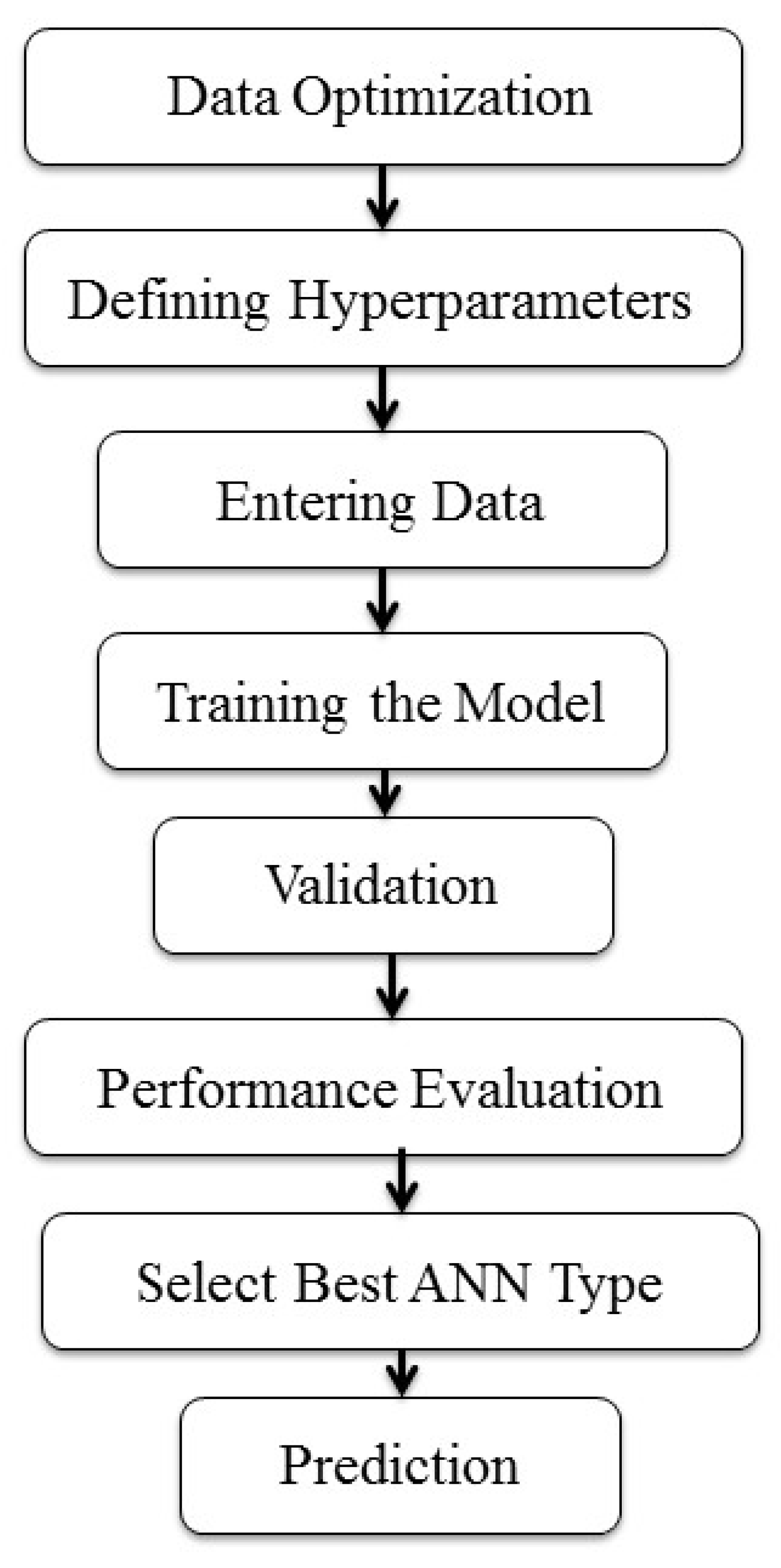
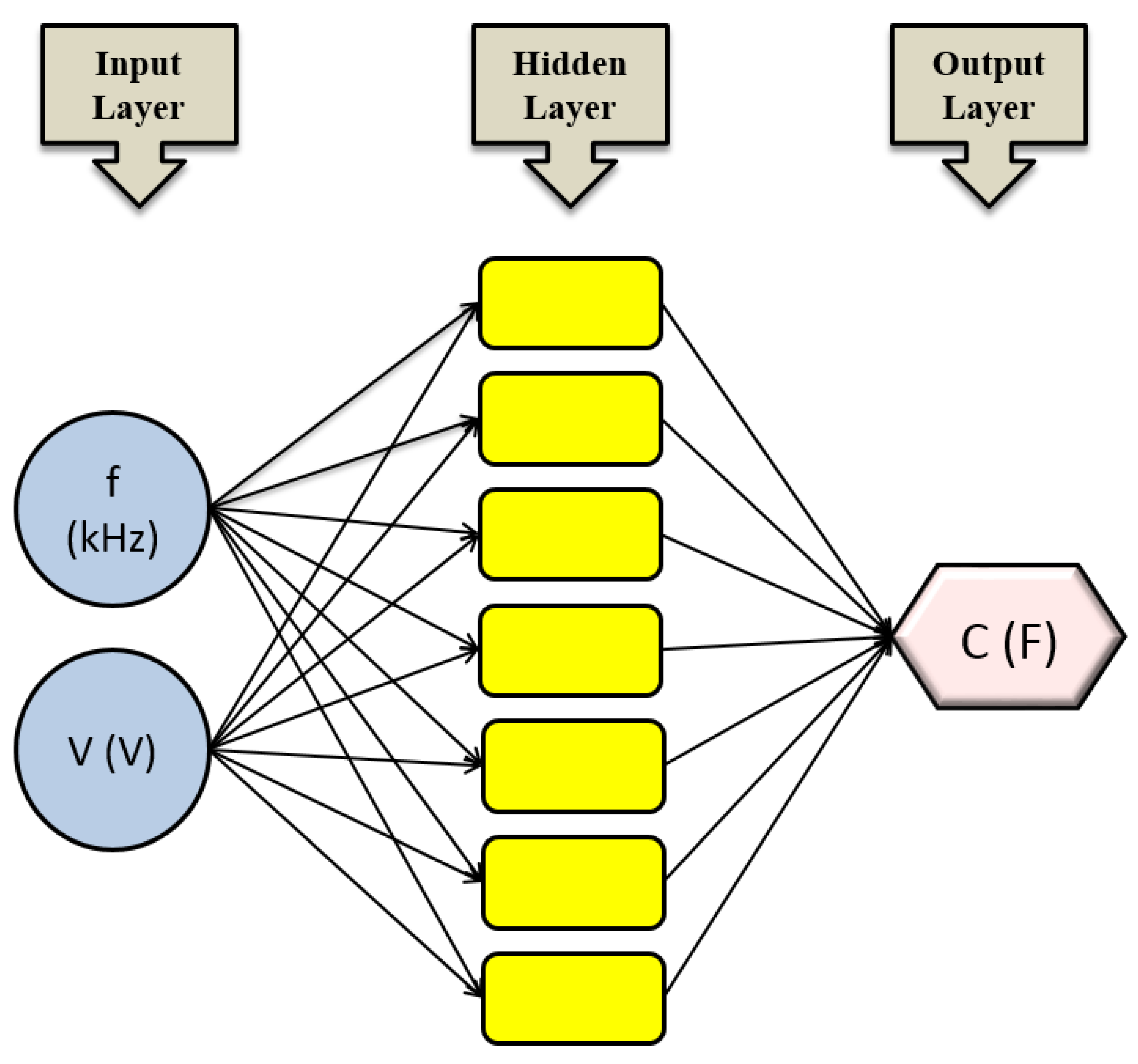
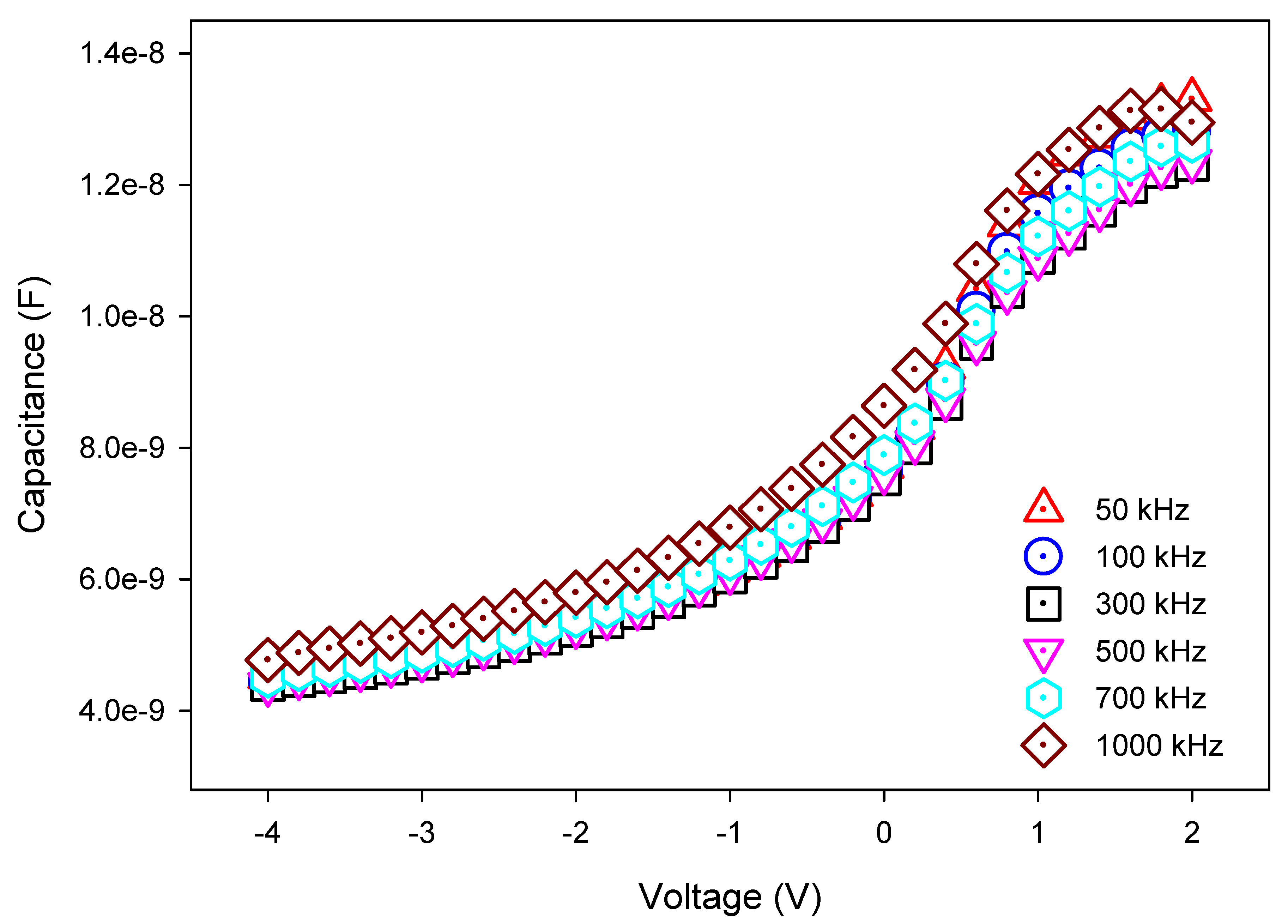
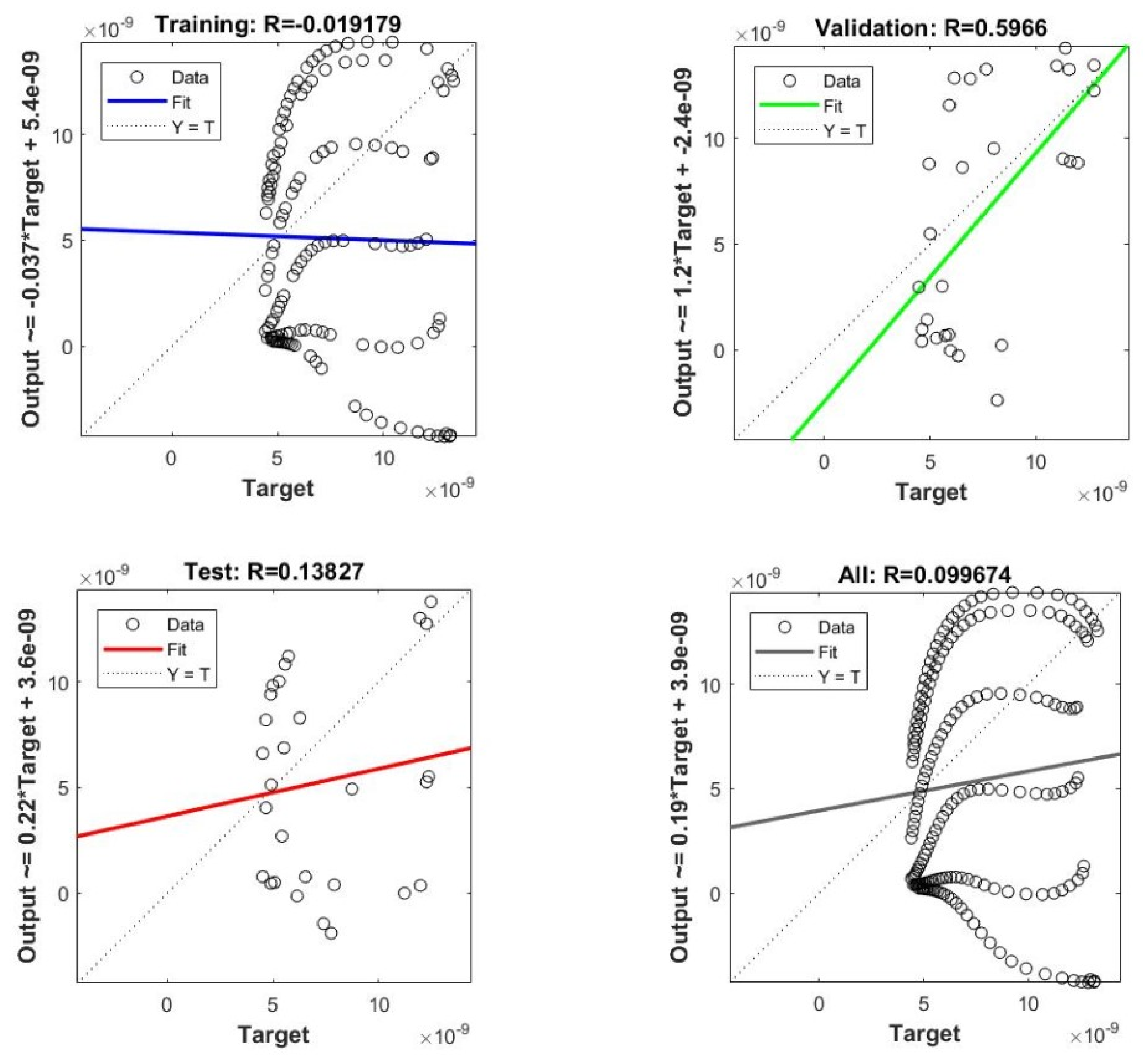
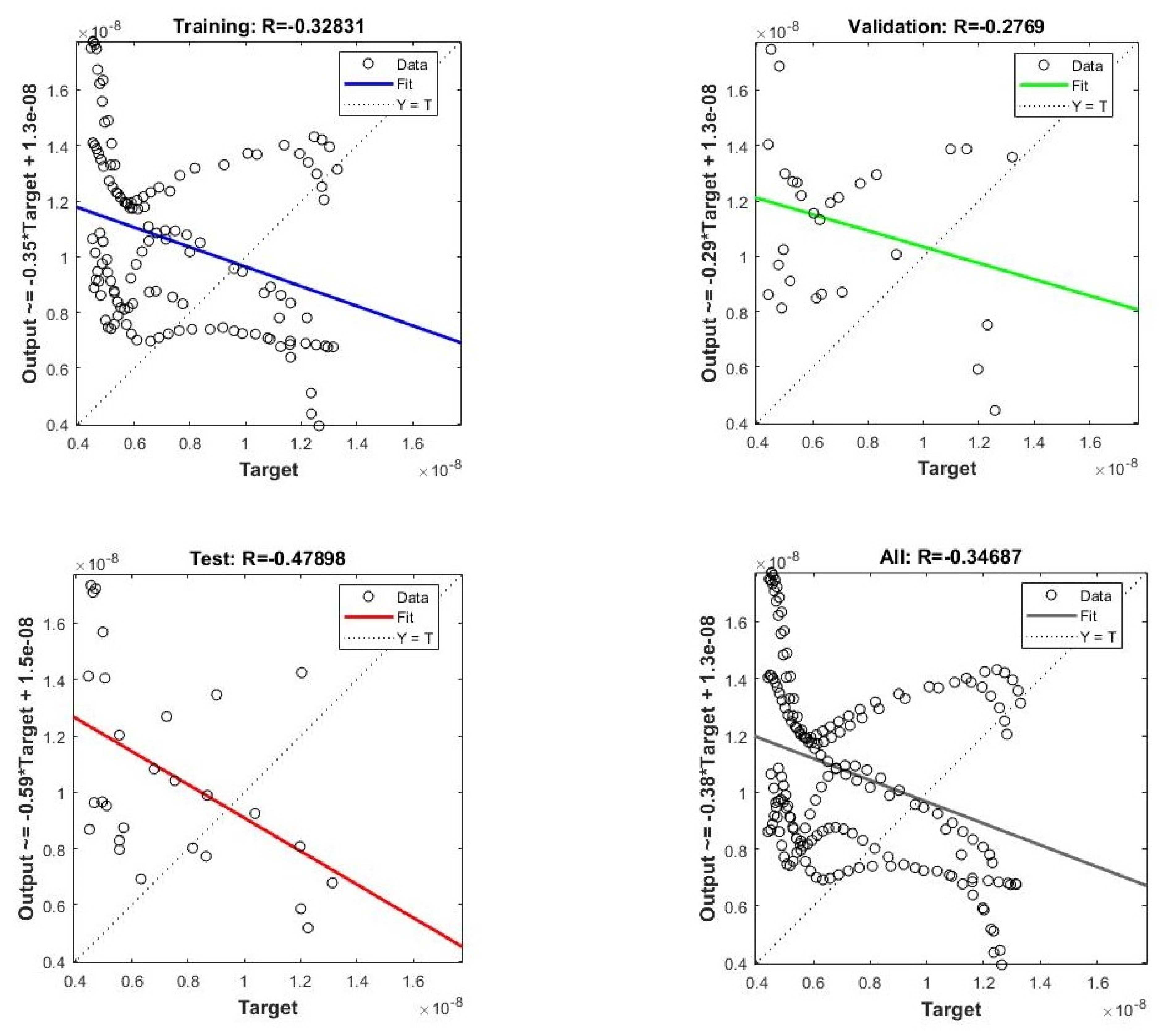
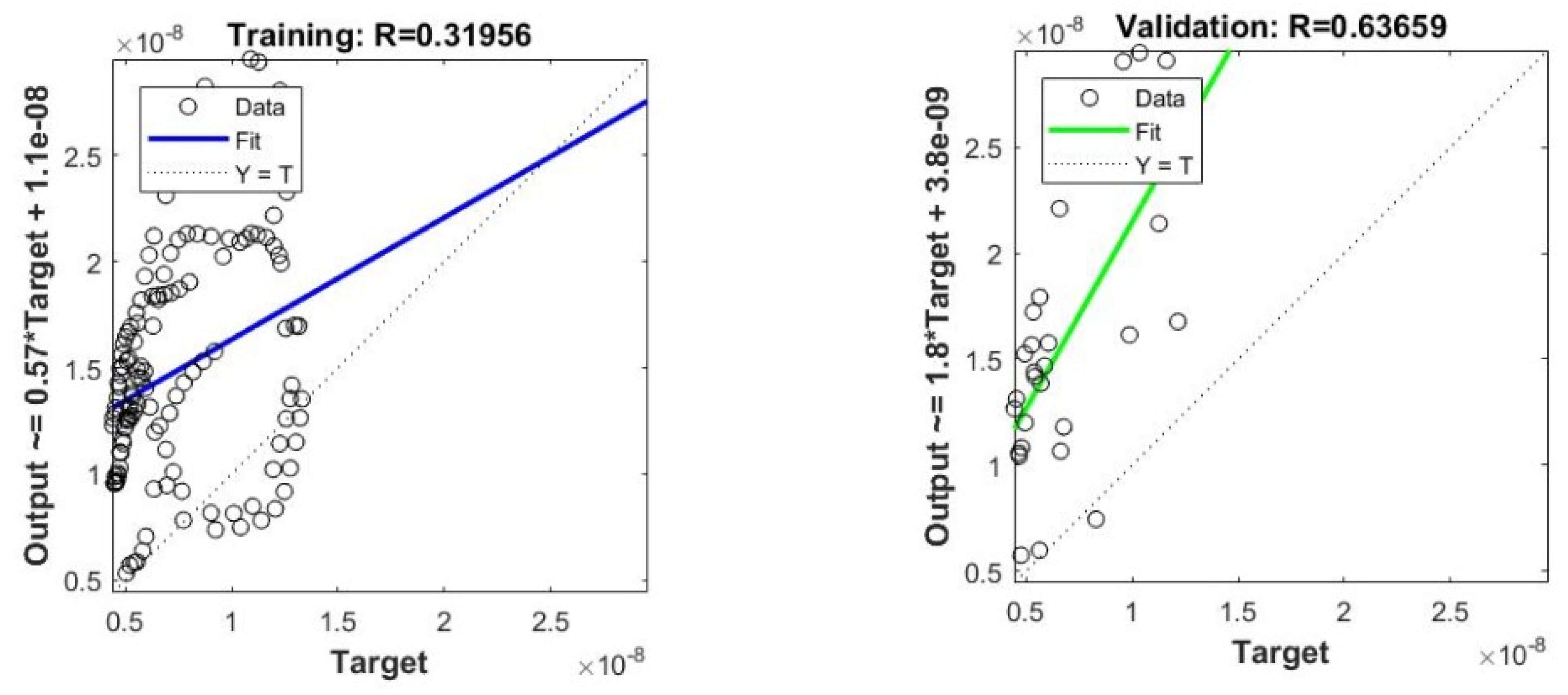
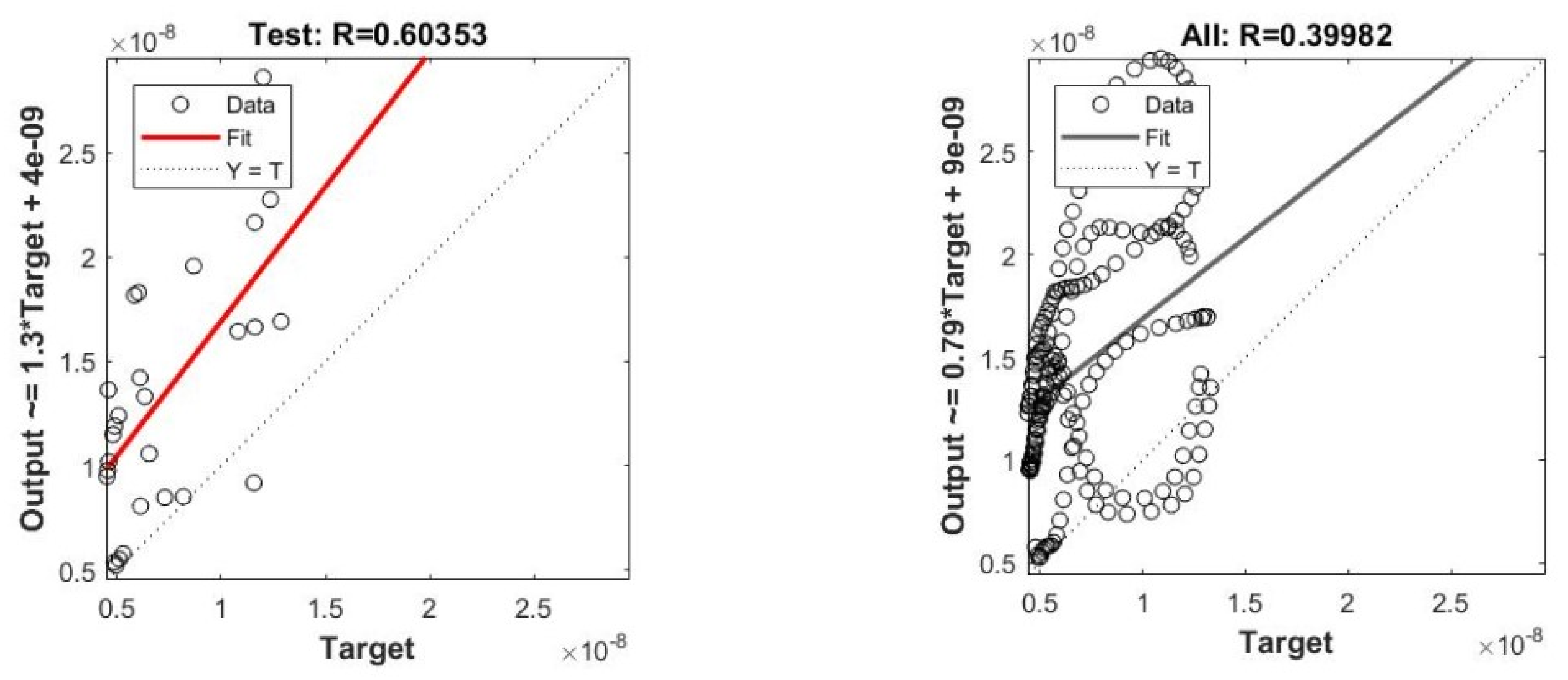
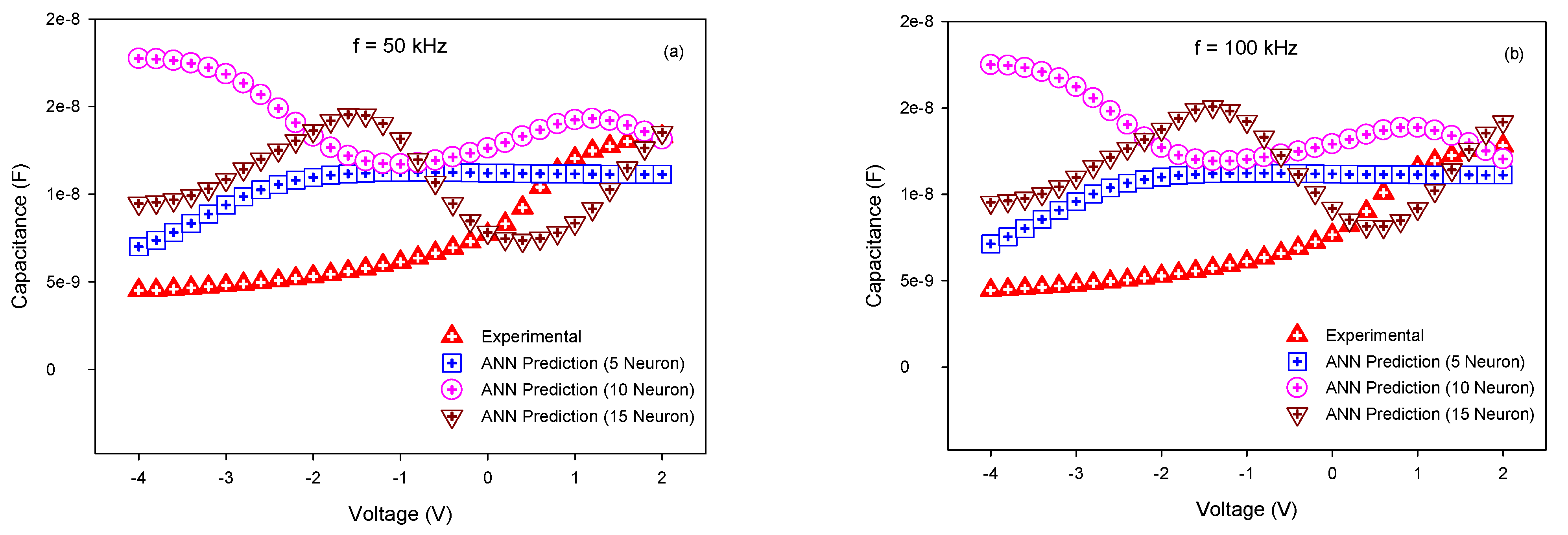


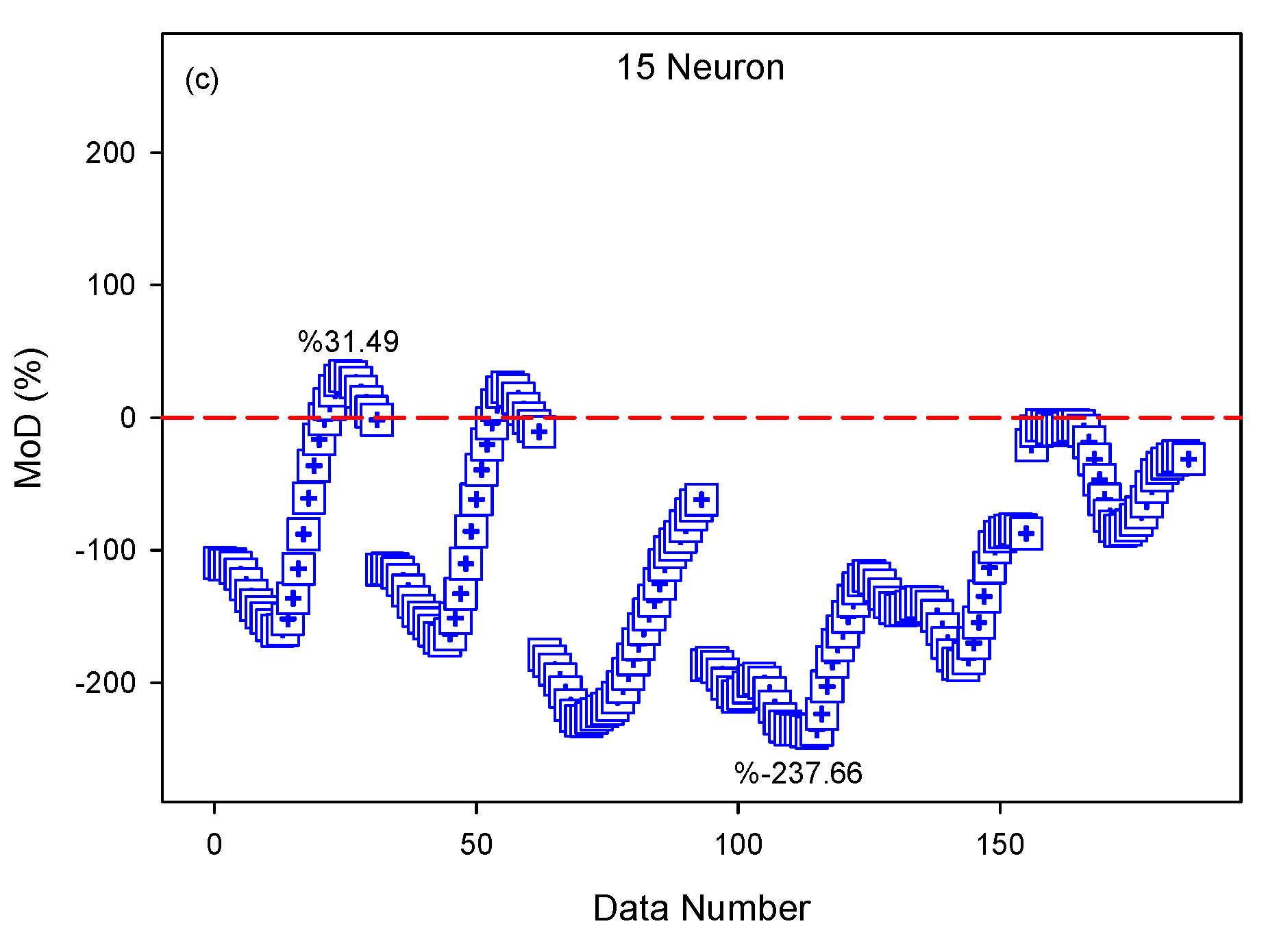
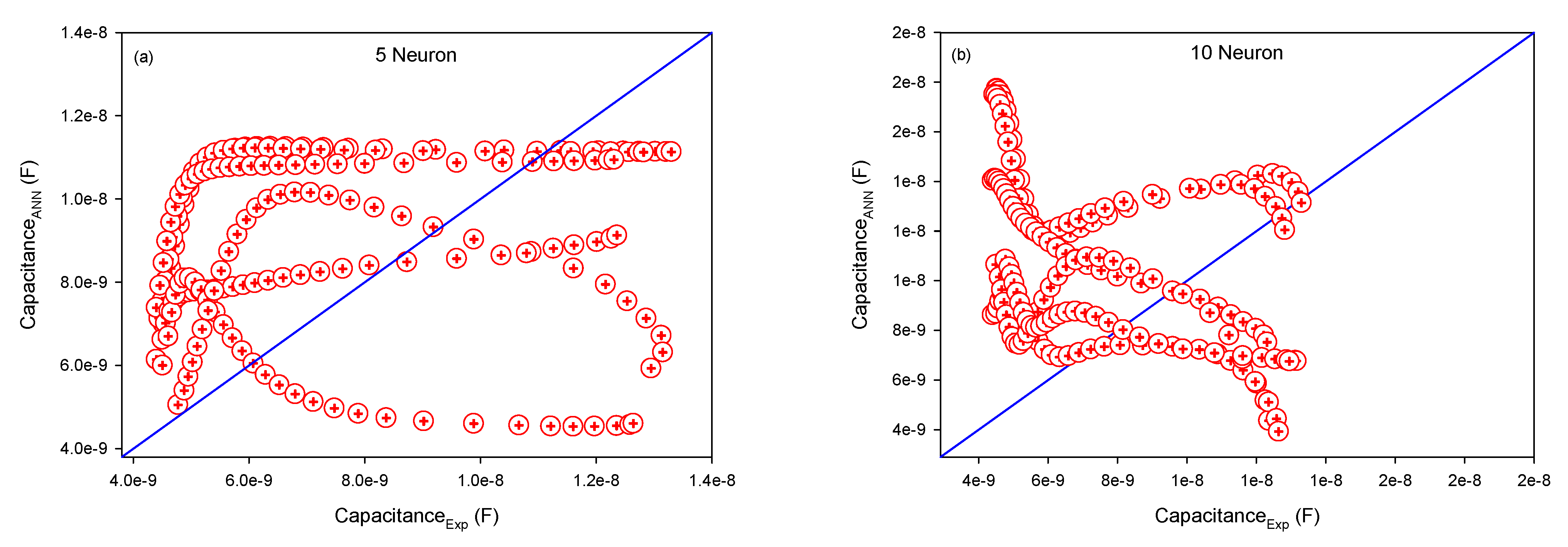

| Model | MSE | R | MoDav (%) |
|---|---|---|---|
| 5 Neuron | 1.39 × 10−17 | 0.09967 | −34.92 |
| 10 Neuron | 3.66 × 10−17 | −0.36140 | −68.64 |
| 15 Neuron | 5.89 × 10−16 | 0.39982 | −114.73 |
Publisher’s Note: MDPI stays neutral with regard to jurisdictional claims in published maps and institutional affiliations. |
© 2022 by the authors. Licensee MDPI, Basel, Switzerland. This article is an open access article distributed under the terms and conditions of the Creative Commons Attribution (CC BY) license (https://creativecommons.org/licenses/by/4.0/).
Share and Cite
Çolak, A.B.; Güzel, T.; Shafiq, A.; Nonlaopon, K. Do Artificial Neural Networks Always Provide High Prediction Performance? An Experimental Study on the Insufficiency of Artificial Neural Networks in Capacitance Prediction of the 6H-SiC/MEH-PPV/Al Diode. Symmetry 2022, 14, 1511. https://doi.org/10.3390/sym14081511
Çolak AB, Güzel T, Shafiq A, Nonlaopon K. Do Artificial Neural Networks Always Provide High Prediction Performance? An Experimental Study on the Insufficiency of Artificial Neural Networks in Capacitance Prediction of the 6H-SiC/MEH-PPV/Al Diode. Symmetry. 2022; 14(8):1511. https://doi.org/10.3390/sym14081511
Chicago/Turabian StyleÇolak, Andaç Batur, Tamer Güzel, Anum Shafiq, and Kamsing Nonlaopon. 2022. "Do Artificial Neural Networks Always Provide High Prediction Performance? An Experimental Study on the Insufficiency of Artificial Neural Networks in Capacitance Prediction of the 6H-SiC/MEH-PPV/Al Diode" Symmetry 14, no. 8: 1511. https://doi.org/10.3390/sym14081511
APA StyleÇolak, A. B., Güzel, T., Shafiq, A., & Nonlaopon, K. (2022). Do Artificial Neural Networks Always Provide High Prediction Performance? An Experimental Study on the Insufficiency of Artificial Neural Networks in Capacitance Prediction of the 6H-SiC/MEH-PPV/Al Diode. Symmetry, 14(8), 1511. https://doi.org/10.3390/sym14081511









